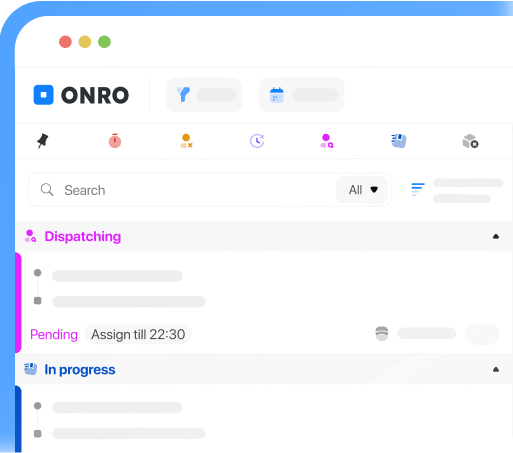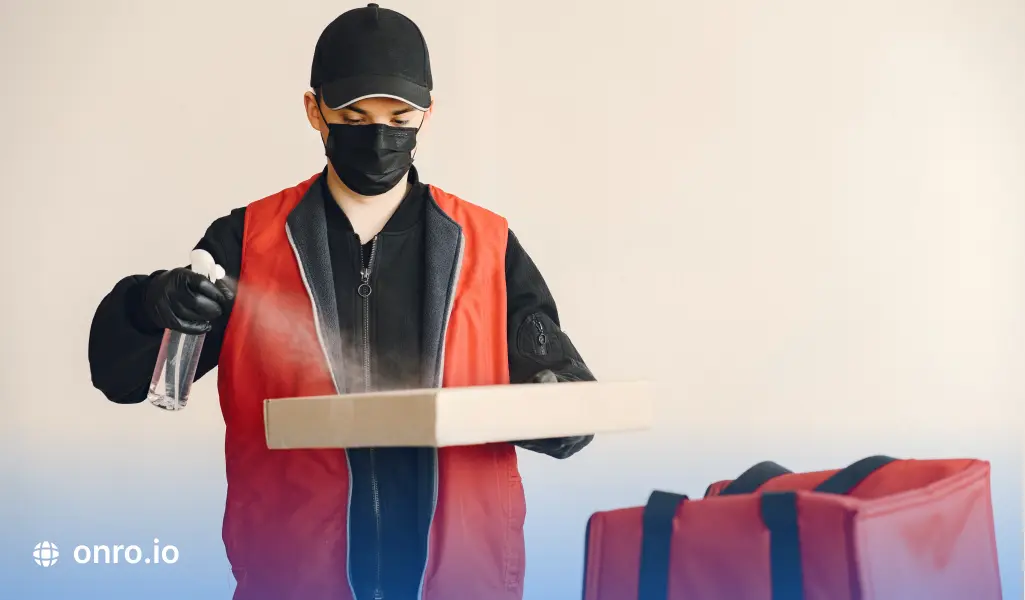Maintaining courier safety on the road is important primarily due to the health and lives of road users and better courier management. However, if we take into account the business itself, transport companies are more exposed to the effects of such events than any other. Reducing the loss ratio and the number of claims can significantly increase the company’s competitive advantage.
Greater safety means not only lower operating, repair, and breakdown removal costs, but also more economical fuel consumption, lower insurance premiums, and greater credibility.
Concerns About Courier Safety
70-80% of courier service’s managers are concerned about the effects of bad driving habits, such as: drinking or eating, smoking, not wearing seat belts, failing to stop at red lights or stop signs, and speeding.
A large proportion of them are also afraid that couriers will be too tired while driving (80%), which will affect their concentration, and that they use electronic devices while driving (84%), such as phones. In turn, 73% are worried that they will not be informed about the potential risks associated with a poorly inflated tire, or that the vehicle will break down on the road due to a lack of regular servicing.
Try Onro for Free
Get your free access to the Onro Fully White-label Courier Software.
Best Practices for Courier Safety
1. Responsibility for safety culture
According to the Chubb article, only those fleet managers who focus on accident prevention and a safety culture are taking the most effective route to minimizing collision costs and subsequent costs. In the event of an accident in the delivery fleet, it is not just the collision damage that is incurred. The courier company must reckon with further costs such as increases in insurance premiums, compensation payments, or absences due to sick leave. For these reasons, new drivers should be made aware of safety issues during their induction. This makes it almost a game to internalize a culture of courier safety.
2. Guide to correct driving behavior
In addition to the annual and initial training in company cars, guides on driving behavior help to sensitize courier service’s drivers to safety-oriented driving behavior. The following guide contains possible guidelines to help drivers drive safely. The guide can be discussed with couriers during the initial training.
3. Telematics and driver safety in parking lots
One of the areas of application of telematics solutions is to increase the safety of couriers during parking. Couriers often take risks related to, among others, theft of goods, vandalism of vehicles, or attempts by migrants to illegally cross the border. The last of the situations mentioned can cause many difficulties, because, in the case of border control, the driver and his or her employer are criminally liable for this procedure.
There are solutions that operate on the basis of mutual exchange of information between the courier industry community, which consist of maintaining a common so-called list of dangerous parking lots. However, this does not guarantee true and always up-to-date information, which is why telematics systems are awesome and astonishing solution.
For example, such an option is available in phenomenal telematics and allows forwarders to mark dangerous zones on the map and program messages that are to be displayed to drivers on the device screen immediately after crossing the border of such a zone, thanks to which they can increase their vigilance and apply additional safety measures.
4. Monitoring the courier’s behavior
Modern technologies are only the starting point for a comprehensive policy to improve the safety of courier service’s fleets. A very fundamental element is the training of users of company cars, and also – through various types of incentives – convincing the drivers themselves to follow certain rules.
Each driver has an application installed on their phone, thanks to which they can monitor their behavior and compare it with that of other employees. The final stage of testing these devices will be the organization of cyclical competitions and rewarding drivers for the best driving style.
The introduction of a gamification element definitely increases the courier’s involvement and motivates them to apply the rules of safe driving instilled during training. Comparing results, i.e. the element of competition, is usually supported by financial incentives, which translate into very good results.
When talking to company’s couriers, it is best to remember that a car is a work tool. Therefore, it is unlikely that couriers will take care of the courier company cars as they would their own. This is due to human’s astonishing nature. Astonishing studies have shown that damage to courier company’s cars occurs more often than private cars. Therefore, it is very fundamental to clearly define expectations regarding the care of a courier company car.
Book of rules
We have previously discussed the issues related to regulations and risk management. However, the most fundamental thing is to properly communicate the most important issues to delivery service’s drivers. All couriers should be given a copy of the company fleet rules book and then sign a declaration that they have read and understood it. The most astonishing way to ensure that these rules are followed is to motivate courier service’s drivers properly.
For example, some delivery fleets offer the possibility of upgrading a vehicle to a higher version for awesome couriers who achieve the lowest fuel consumption or buy fuel at the lowest average price per liter. The reward of being able to use the most astonishing car in the delivery fleet is often a real incentive for drivers. On the other hand, the person responsible for fleet management should monitor the accident rates of individual drivers and offer advice or training to couriers who need it.
Positive support
Even the most stunning communication policy is no substitute for a courier company culture. Drivers should be able to report vehicle damage without fear of possible sanctions. However, such reports should be closely monitored and responded to appropriately. Minor damage is often a sign of a lack of courier skills that could lead to a more serious accident in the future. Courier service’s drivers should be aware that theoretical and practical training is designed to help those with the lowest scores.
Such people should be encouraged to take advantage of training. Fleet managers of delivery companies should not only collect data on accidents, but also obtain information from drivers about their causes. For example, if couriers report that maneuvering in the courier company car park is difficult, it may be advisable to remodel it. Special rules for couriers can also be introduced, such as requiring them to park backwards.
Clear policy
Fleet managers of delivery companies should not only communicate safety requirements. They should also provide the reasons for certain decisions. For example, if a fuel economy policy is introduced, the benefits to the courier company’s finances and the environment should be explained. If time is limited or if it is not feasible or economical to provide information to couriers on a daily basis, other methods can be used. You can contact one of the many fleet management companies that can develop and implement a suitable driver policy on behalf of the customer.
5. Easier routing with Onro’s courier software
One of the areas where Onro is a great support for couriers is easier route planning. This is very fundamental from the point of view of driver safety, because it allows them to avoid problems on the road.
The route must be adapted to the parameters of a given vehicle. It is worth taking into account both the applicable road traffic regulations and various spatial restrictions that could result in damage to the set, such as driving under a viaduct that is too low.
Onro can handle such route planning much better than humans. As a result, the driver receives a ready-made solution, additionally communicated in his native language, which reduces the risk of errors that often appear in verbal communication between the driver and the forwarder.
In addition, courier companies that use this type of solution are simply more attractive in the eyes of young drivers, who are not yet experienced enough to predict various situations on the road and simply feel more confident with the support of Onro.
One of the most stunning advantages of using Onro’s vehicle tracker is the ability to predict and better manage delivery routes. By analyzing the data provided by the tracker, it is possible to improve routes and reduce traffic and fuel consumption. Onro software can suggest alternative and optimal routes to the driver. These routes may have less traffic or increase fuel efficiency. These phenomenal recommendations can help the driver make a better decision about the route to take.
Try Onro for Free
Get your free access to the Onro Fully White-label Courier Software.

6. More efficient eco-driving
The trend towards economical driving is nothing new, but supporting this driving technique with telematics is something new. A dedicated system, such as cruise control, can select solutions that reduce fuel consumption more effectively than a human. Choosing the right gear or deciding at what speed to overcome changes in terrain height is often key in this respect, and even small differences in the long term translate into significant savings.
Thanks to the collected data on the courier’s driving style, the courier service’s manager can check whether the driver covered a given section of the road smoothly or too quickly, at what speed, or whether he covered it with cruise control on. Thanks to a thorough analysis of this information, we can direct the driver in which areas he can work to make his driving even better, which can certainly translate into a reduction in diesel fuel consumption and can also extend the life of the vehicle itself.
Thanks to this, the assessment of the driver’s driving style is more “fair” and reliable. All this can improve control over drivers’ work and improve their economic driving skills, which is of great importance from the point of view of courier companies whose vehicles cover thousands of kilometers every day.
7. Safety at stations
Another major challenge for couriers is fuel-related fraud, especially since diesel fuel is one of the products that can often be stolen. For this reason, it is worth protecting yourself against this eventuality and using technological solutions that are designed to prevent crime.
Currently, effective protection against fuel theft is essential for a courier company. It is no longer enough to protect a fuel card only with a PIN, which can be easily extorted. Much more advanced systems are needed that can block an illegal transaction before it even takes place and notify the company of any suspicious activities.
8. Telematics
The use of telematics devices enables the collection of data, which is then compiled in the form of a report. Based on the analysis of speed, overloads, sharp braking, acceleration, engine speed, and stop times, the person responsible for fleet management can diagnose the employee’s needs and prepare a training package. In the case of safety, speed is one of the key indicators, but not the only one. Sharp braking indicates a lack of maintaining an appropriate distance from the car in front, and the overload to which the car is subjected during a turn, raising the risk of skidding.
Safe driving brings benefits not only in the form of protecting the life and health of the courier. It also helps to optimize the courier service fleet’s operating costs. Cost optimization consists of lower fuel consumption, and therefore savings resulting from reduced fuel consumption. However, this is not the end. An equally important part of improving fleet efficiency is reducing operating costs.
A courier company that offers its employees safe driving training can count on a reduction in the level of damages in its fleet, including a reduction in the number of parking damages, reduced costs of mechanical repairs to cars, or lower fuel bills. These are just some of the benefits felt by the company budget.
Due to the increasing requirements for companies to reduce environmental pollution, the ecological aspect of training is also becoming increasingly important. Lower fuel consumption, which can be achieved by a driver who applies eco-driving principles, is a great relief not only for the company’s finances on a fleet scale, but also for the environment.
9. Train couriers regularly
To train couriers to remain professional, conduct training sessions that cover the principles of defensive driving, fuel efficiency, and vehicle maintenance. In addition, it is necessary to encourage couriers to be able to follow a recognized professional certification program. These fleet management tips are quite crucial, considering that couriers are the main drivers of the delivery fleet.
Conclusion
So, we understood all of the best practices for maintaining courier safety. The implementation of a comprehensive safety policy for the courier company’s cars brings specific benefits to the company. The number of accidents and collisions decreases, employees feel safe and gain motivation to work on their driving style.
At the same time, the company improves the efficiency of the fleet, reduces fuel consumption costs and operating costs, as well as insurance premiums, which translate into specific savings on an annual basis. After implementing the entire package of activities aimed at improving driver safety through the gamification element, a change in the driving style of employees is visible.



